HSBC 2005 Annual Report Download - page 400
Download and view the complete annual report
Please find page 400 of the 2005 HSBC annual report below. You can navigate through the pages in the report by either clicking on the pages listed below, or by using the keyword search tool below to find specific information within the annual report.-
 1
1 -
 2
2 -
 3
3 -
 4
4 -
 5
5 -
 6
6 -
 7
7 -
 8
8 -
 9
9 -
 10
10 -
 11
11 -
 12
12 -
 13
13 -
 14
14 -
 15
15 -
 16
16 -
 17
17 -
 18
18 -
 19
19 -
 20
20 -
 21
21 -
 22
22 -
 23
23 -
 24
24 -
 25
25 -
 26
26 -
 27
27 -
 28
28 -
 29
29 -
 30
30 -
 31
31 -
 32
32 -
 33
33 -
 34
34 -
 35
35 -
 36
36 -
 37
37 -
 38
38 -
 39
39 -
 40
40 -
 41
41 -
 42
42 -
 43
43 -
 44
44 -
 45
45 -
 46
46 -
 47
47 -
 48
48 -
 49
49 -
 50
50 -
 51
51 -
 52
52 -
 53
53 -
 54
54 -
 55
55 -
 56
56 -
 57
57 -
 58
58 -
 59
59 -
 60
60 -
 61
61 -
 62
62 -
 63
63 -
 64
64 -
 65
65 -
 66
66 -
 67
67 -
 68
68 -
 69
69 -
 70
70 -
 71
71 -
 72
72 -
 73
73 -
 74
74 -
 75
75 -
 76
76 -
 77
77 -
 78
78 -
 79
79 -
 80
80 -
 81
81 -
 82
82 -
 83
83 -
 84
84 -
 85
85 -
 86
86 -
 87
87 -
 88
88 -
 89
89 -
 90
90 -
 91
91 -
 92
92 -
 93
93 -
 94
94 -
 95
95 -
 96
96 -
 97
97 -
 98
98 -
 99
99 -
 100
100 -
 101
101 -
 102
102 -
 103
103 -
 104
104 -
 105
105 -
 106
106 -
 107
107 -
 108
108 -
 109
109 -
 110
110 -
 111
111 -
 112
112 -
 113
113 -
 114
114 -
 115
115 -
 116
116 -
 117
117 -
 118
118 -
 119
119 -
 120
120 -
 121
121 -
 122
122 -
 123
123 -
 124
124 -
 125
125 -
 126
126 -
 127
127 -
 128
128 -
 129
129 -
 130
130 -
 131
131 -
 132
132 -
 133
133 -
 134
134 -
 135
135 -
 136
136 -
 137
137 -
 138
138 -
 139
139 -
 140
140 -
 141
141 -
 142
142 -
 143
143 -
 144
144 -
 145
145 -
 146
146 -
 147
147 -
 148
148 -
 149
149 -
 150
150 -
 151
151 -
 152
152 -
 153
153 -
 154
154 -
 155
155 -
 156
156 -
 157
157 -
 158
158 -
 159
159 -
 160
160 -
 161
161 -
 162
162 -
 163
163 -
 164
164 -
 165
165 -
 166
166 -
 167
167 -
 168
168 -
 169
169 -
 170
170 -
 171
171 -
 172
172 -
 173
173 -
 174
174 -
 175
175 -
 176
176 -
 177
177 -
 178
178 -
 179
179 -
 180
180 -
 181
181 -
 182
182 -
 183
183 -
 184
184 -
 185
185 -
 186
186 -
 187
187 -
 188
188 -
 189
189 -
 190
190 -
 191
191 -
 192
192 -
 193
193 -
 194
194 -
 195
195 -
 196
196 -
 197
197 -
 198
198 -
 199
199 -
 200
200 -
 201
201 -
 202
202 -
 203
203 -
 204
204 -
 205
205 -
 206
206 -
 207
207 -
 208
208 -
 209
209 -
 210
210 -
 211
211 -
 212
212 -
 213
213 -
 214
214 -
 215
215 -
 216
216 -
 217
217 -
 218
218 -
 219
219 -
 220
220 -
 221
221 -
 222
222 -
 223
223 -
 224
224 -
 225
225 -
 226
226 -
 227
227 -
 228
228 -
 229
229 -
 230
230 -
 231
231 -
 232
232 -
 233
233 -
 234
234 -
 235
235 -
 236
236 -
 237
237 -
 238
238 -
 239
239 -
 240
240 -
 241
241 -
 242
242 -
 243
243 -
 244
244 -
 245
245 -
 246
246 -
 247
247 -
 248
248 -
 249
249 -
 250
250 -
 251
251 -
 252
252 -
 253
253 -
 254
254 -
 255
255 -
 256
256 -
 257
257 -
 258
258 -
 259
259 -
 260
260 -
 261
261 -
 262
262 -
 263
263 -
 264
264 -
 265
265 -
 266
266 -
 267
267 -
 268
268 -
 269
269 -
 270
270 -
 271
271 -
 272
272 -
 273
273 -
 274
274 -
 275
275 -
 276
276 -
 277
277 -
 278
278 -
 279
279 -
 280
280 -
 281
281 -
 282
282 -
 283
283 -
 284
284 -
 285
285 -
 286
286 -
 287
287 -
 288
288 -
 289
289 -
 290
290 -
 291
291 -
 292
292 -
 293
293 -
 294
294 -
 295
295 -
 296
296 -
 297
297 -
 298
298 -
 299
299 -
 300
300 -
 301
301 -
 302
302 -
 303
303 -
 304
304 -
 305
305 -
 306
306 -
 307
307 -
 308
308 -
 309
309 -
 310
310 -
 311
311 -
 312
312 -
 313
313 -
 314
314 -
 315
315 -
 316
316 -
 317
317 -
 318
318 -
 319
319 -
 320
320 -
 321
321 -
 322
322 -
 323
323 -
 324
324 -
 325
325 -
 326
326 -
 327
327 -
 328
328 -
 329
329 -
 330
330 -
 331
331 -
 332
332 -
 333
333 -
 334
334 -
 335
335 -
 336
336 -
 337
337 -
 338
338 -
 339
339 -
 340
340 -
 341
341 -
 342
342 -
 343
343 -
 344
344 -
 345
345 -
 346
346 -
 347
347 -
 348
348 -
 349
349 -
 350
350 -
 351
351 -
 352
352 -
 353
353 -
 354
354 -
 355
355 -
 356
356 -
 357
357 -
 358
358 -
 359
359 -
 360
360 -
 361
361 -
 362
362 -
 363
363 -
 364
364 -
 365
365 -
 366
366 -
 367
367 -
 368
368 -
 369
369 -
 370
370 -
 371
371 -
 372
372 -
 373
373 -
 374
374 -
 375
375 -
 376
376 -
 377
377 -
 378
378 -
 379
379 -
 380
380 -
 381
381 -
 382
382 -
 383
383 -
 384
384 -
 385
385 -
 386
386 -
 387
387 -
 388
388 -
 389
389 -
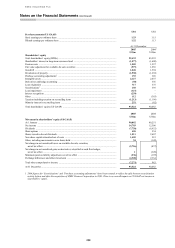 390
390 -
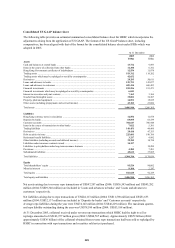 391
391 -
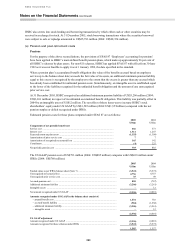 392
392 -
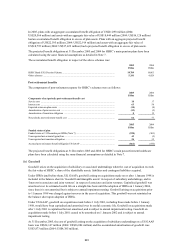 393
393 -
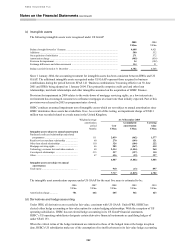 394
394 -
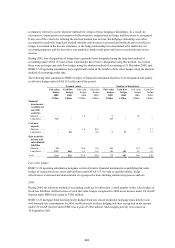 395
395 -
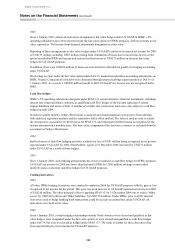 396
396 -
 397
397 -
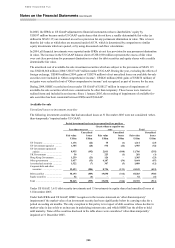 398
398 -
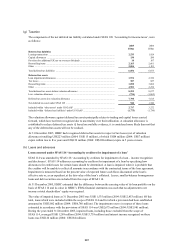 399
399 -
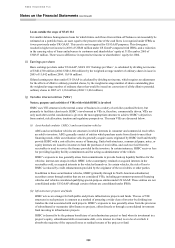 400
400 -
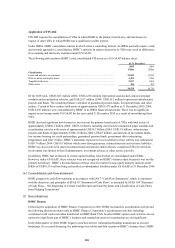 401
401 -
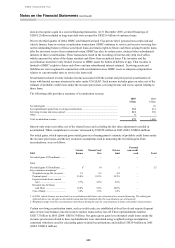 402
402 -
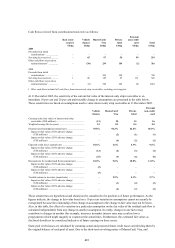 403
403 -
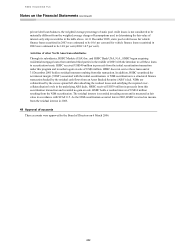 404
404 -
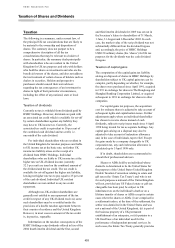 405
405 -
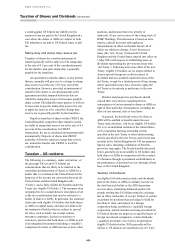 406
406 -
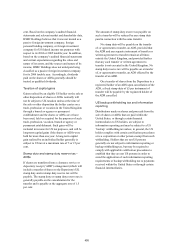 407
407 -
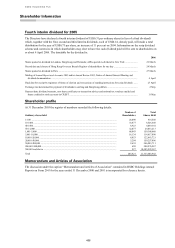 408
408 -
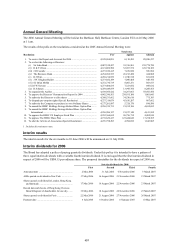 409
409 -
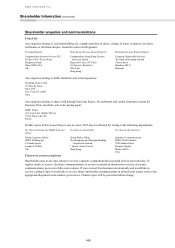 410
410 -
 411
411 -
 412
412 -
 413
413 -
 414
414 -
 415
415 -
 416
416 -
 417
417 -
 418
418 -
 419
419 -
 420
420 -
 421
421 -
 422
422 -
 423
423 -
 424
424
 |
 |

HSBC HOLDINGS PLC
Notes on the Financial Statements (continued)
398
Loans outside the scope of SFAS 114
For smaller-balance homogeneous loans for which future cash flows from written-off balances can reasonably be
estimated on a portfolio basis, an asset equal to the present value of the cash flows is recognised under IFRSs as
it was previously under UK GAAP. This asset is not recognised for US GAAP purposes. This divergence
resulted in higher net income in 2005 of US$20 million under US GAAP compared with IFRSs, and a reduction
in the carrying value of loans and advances to customers and shareholders’ equity at 31 December 2005 of
US$327 million. There was no difference in reported net income or shareholders’ equity for 2004.
(i) Earnings per share
Basic earnings per share under US GAAP, SFAS 128 ‘Earnings per Share’, is calculated by dividing net income
of US$14,703 million (2004: US$12,506 million) by the weighted average number of ordinary shares in issue in
2005 of 11,042 million (2004: 10,916 million).
Diluted earnings per share under US GAAP is calculated by dividing net income, which requires no adjustment
for the effects of dilutive ordinary potential shares, by the weighted average number of shares outstanding plus
the weighted average number of ordinary shares that would be issued on conversion of all the dilutive potential
ordinary shares in 2005 of 11,334 million (2004: 11,063 million).
(j) Variable interest entities (‘VIEs’)
Nature, purpose and activities of VIEs with which HSBC is involved
HSBC uses VIE structures in the normal course of business in a variety of activities (outlined below), but
primarily to facilitate client needs. HSBC’s involvement in VIEs is, therefore, commercially driven. VIEs are
only used after careful consideration is given to the most appropriate structure to achieve HSBC’s objectives
from control, risk allocation, taxation and regulatory perspectives. The main VIEs are discussed below.
(i) Asset-backed conduits (‘ABCs’) and securitisation vehicles
ABCs and securitisation vehicles are structures in which interests in consumer and commercial receivables
are sold to investors. ABCs generally consist of entities which purchase assets from clients to meet their
financing needs, while securitisation vehicles generally acquire assets originated by HSBC itself and thereby
provide HSBC with a cost-effective source of financing. Under both structures, commercial paper, notes, or
equity interests are issued to investors to fund the purchase of receivables, and cash received from the
receivables is used to service the finance provided by the investors. In certain instances, HSBC receives fees
for providing liquidity facility commitments and for acting as administrator of the vehicle.
HSBC’s exposure to loss generally arises from commitments to provide back-up liquidity facilities for the
vehicles; interest-rate swaps in which HSBC is the counterparty; retained or acquired interests in the
receivables sold; or acquired interests in the vehicles themselves. In certain vehicles, the risk of loss to
HSBC is reduced by credit enhancements provided by the originator of the receivables or other parties.
In addition to these securitisation vehicles, HSBC (primarily through its North American subsidiaries)
securitises assets through entities that are not considered VIEs, including government-sponsored financing
vehicles and vehicles considered qualifying special-purpose entities under US GAAP. These entities are not
consolidated under US GAAP although certain of them are consolidated under IFRSs.
(ii) Infrastructure projects and funds
HSBC acts as an arranger for both public and private infrastructure projects and funds. The use of VIE
structures in such projects is common as a method of attracting a wider class of investor by dividing into
tranches the risk associated with such projects. HSBC’s exposure to loss generally arises from the provision
of subordinated or mezzanine debt finance to projects, either directly or through a consolidated investment
fund investing in infrastructure projects.
HSBC is deemed to be the primary beneficiary of an infrastructure project or fund when its investment in a
project’s equity, subordinated debt or mezzanine debt, or its interest in a fund, is at a level at which it
absorbs the majority of the expected losses or residual returns of the project or fund.
